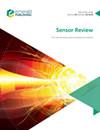超材料传感器材料特性研究综述
IF 1.4
4区 工程技术
Q3 INSTRUMENTS & INSTRUMENTATION
引用次数: 0
摘要
目的本文旨在集中研究过去十年中基于超材料(MTM)的材料表征传感器,包括固体电介质、微流体和生物分子。设计/方法论/方法自过去几十年以来,基于MTM的传感器取得了巨大的进步。MTM元件提供对材料的灵敏响应,同时具有微小的占地面积,使其成为实现各种传感设备的有吸引力的替代方案。发现本报告综述了在知名期刊上发表的关于MTM传感器的相关研究论文,特别强调了所表征材料的结构、尺寸和性质。由于电磁波相互作用激发MTM结构,因此围绕电磁频谱的传感应用是可能的。原创性/价值本文包含了用于材料表征的MTM传感器技术的宝贵信息,本研究还强调了指导未来发展的挑战和方法。本文章由计算机程序翻译,如有差异,请以英文原文为准。
A review: material characterization with metamaterial based sensors
Purpose
This paper aims to concentrate on research that has been conducted in the previous decade on metamaterial (MTM)-based sensors for material characterization, which includes solid dielectrics, micro fluids and biomolecules.
Design/methodology/approach
There has been a vast advancement in sensors based on MTM since the past few decades. MTM elements provide a sensitive response to materials while having a tiny footprint, making them an appealing alternative for realizing diverse sensing devices.
Findings
Related research papers on MTM sensors published in reputable journals were reviewed in this report, with a specific emphasis on the structure, size and nature of the materials characterized. Because electromagnetic wave interaction excites MTM structures, sensing applications around the electromagnetic spectrum are possible.
Originality/value
The paper contains valuable information on MTM sensor technology for material characterization, and this study also highlights the challenges and approaches that will guide future development.
求助全文
通过发布文献求助,成功后即可免费获取论文全文。
去求助
来源期刊

Sensor Review
工程技术-仪器仪表
CiteScore
3.40
自引率
6.20%
发文量
50
审稿时长
3.7 months
期刊介绍:
Sensor Review publishes peer reviewed state-of-the-art articles and specially commissioned technology reviews. Each issue of this multidisciplinary journal includes high quality original content covering all aspects of sensors and their applications, and reflecting the most interesting and strategically important research and development activities from around the world. Because of this, readers can stay at the very forefront of high technology sensor developments.
Emphasis is placed on detailed independent regular and review articles identifying the full range of sensors currently available for specific applications, as well as highlighting those areas of technology showing great potential for the future. The journal encourages authors to consider the practical and social implications of their articles.
All articles undergo a rigorous double-blind peer review process which involves an initial assessment of suitability of an article for the journal followed by sending it to, at least two reviewers in the field if deemed suitable.
Sensor Review’s coverage includes, but is not restricted to:
Mechanical sensors – position, displacement, proximity, velocity, acceleration, vibration, force, torque, pressure, and flow sensors
Electric and magnetic sensors – resistance, inductive, capacitive, piezoelectric, eddy-current, electromagnetic, photoelectric, and thermoelectric sensors
Temperature sensors, infrared sensors, humidity sensors
Optical, electro-optical and fibre-optic sensors and systems, photonic sensors
Biosensors, wearable and implantable sensors and systems, immunosensors
Gas and chemical sensors and systems, polymer sensors
Acoustic and ultrasonic sensors
Haptic sensors and devices
Smart and intelligent sensors and systems
Nanosensors, NEMS, MEMS, and BioMEMS
Quantum sensors
Sensor systems: sensor data fusion, signals, processing and interfacing, signal conditioning.
 求助内容:
求助内容: 应助结果提醒方式:
应助结果提醒方式:


